The ketogenic diet, often referred to as keto, has become a popular strategy for individuals seeking weight loss. By significantly reducing carbohydrate intake and replacing it with fat, the body enters a metabolic state known as ketosis, where it becomes efficient at burning fat for energy. This shift in metabolism is the cornerstone of the diet’s approach to weight loss and is supported by the consumption of high-fat, low-carb foods that help maintain satiety and reduce overall calorie intake.
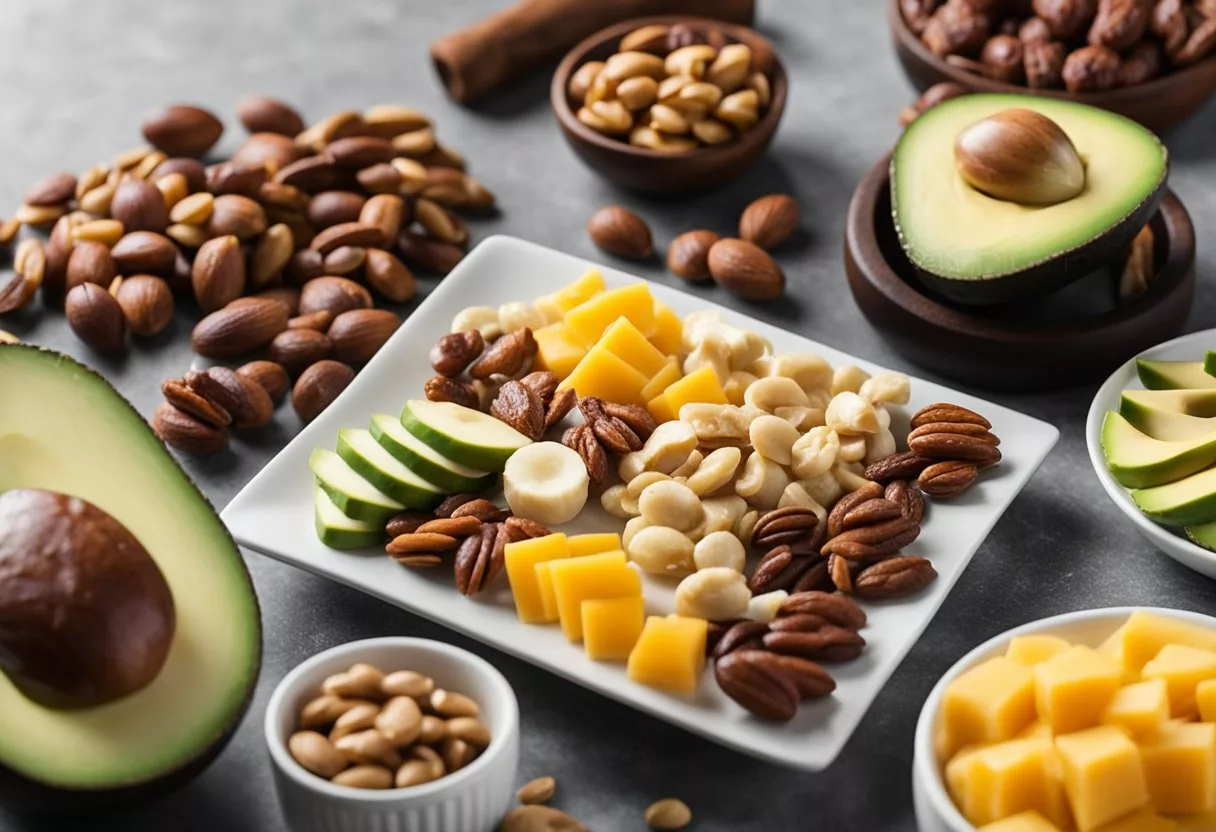
Snacking on a keto diet requires careful selection to adhere to its strict macronutrient ratios, particularly low net carb counts. Keto-friendly snacks such as cheese, avocados, and nuts not only align with the low-carb requirement but are also rich in healthy fats, which is crucial for maintaining ketosis. These snacks can play a pivotal role in managing hunger between meals without compromising the diet’s effectiveness.
Selecting appropriate keto snacks is essential for staying within the diet’s parameters while enabling weight management. Choices like mallow munch bars, which mimic the satisfying crunch of rice treats with minimal net carbs, and granola bars designed for the keto dieter offer convenience without added sugar or artificial ingredients.
As the diet grows in popularity, a growing range of snacks tailored to the keto lifestyle has become available, catering to the need for variety without sacrificing nutritional goals.
Understanding the Keto Diet
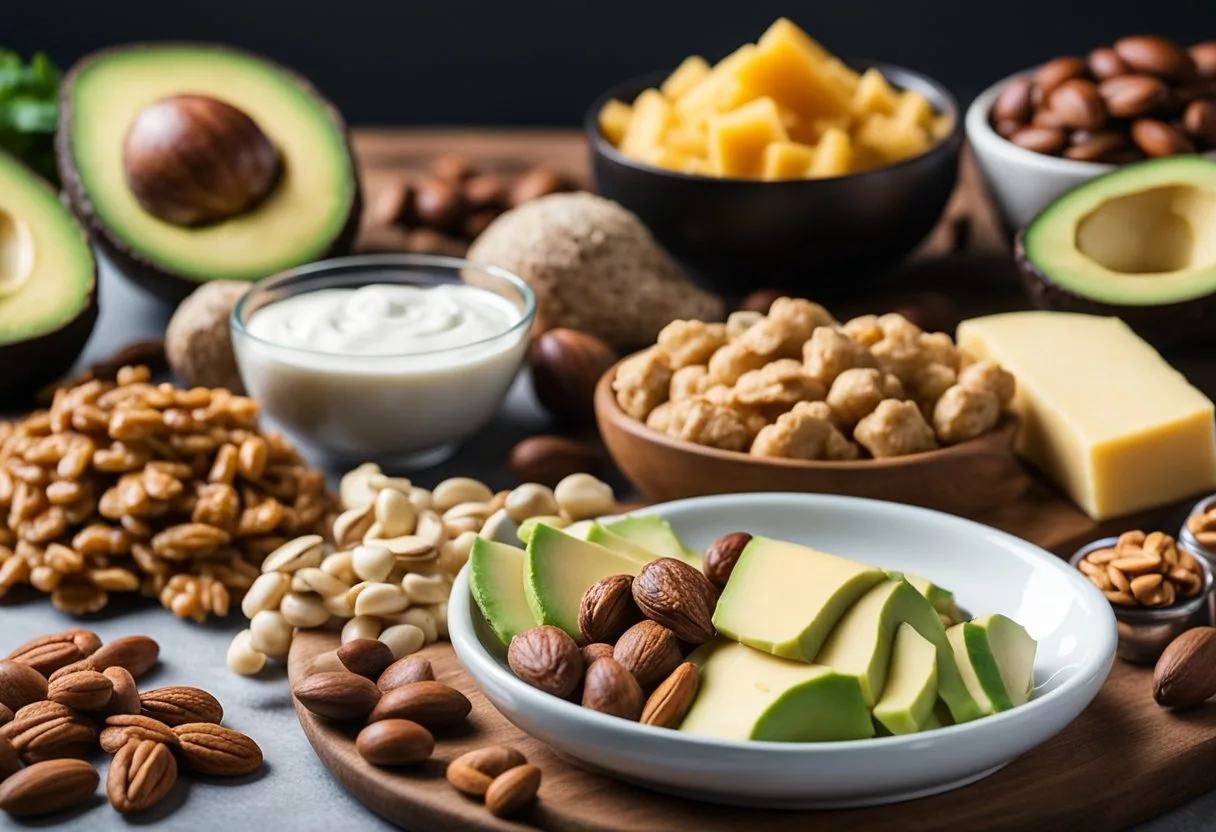
The ketogenic, or “keto,” diet leverages a metabolic state known as ketosis to encourage the body to burn fat for fuel rather than carbohydrates. This section breaks down the foundational principles of ketosis alongside its distinct macronutrient requirements.
Principles of Ketosis
Ketosis occurs when the body has insufficient glucose (derived from carbs) for energy and begins to burn stored fats instead; this process results in the production of molecules called ketones. Individuals seeking weight loss often opt for this diet because it essentially turns the body into a fat-burning machine. Successfully entering ketosis not only increases fat metabolism but also typically reduces hunger, which can assist with a caloric deficit.
- Ketones: Chemicals produced by the liver when breaking down fats
- Ketosis: A metabolic state indicative of increased fat burning
Macronutrient Ratios
A standard ketogenic diet is characterized by a specific ratio of macronutrients that differs significantly from a typical diet. High intake of fats, moderate protein, and very low carbohydrate consumption are crucial. Carbs are restricted to encourage ketosis, while the consumption of fat is increased to provide an alternative fuel source. The protein is moderated to prevent excess gluconeogenesis, which can pull the body out of ketosis.
- Fats: 60-75% of total daily calories
- Proteins: 20-35% of total daily calories
- Carbs: Approximately 5% of total daily calories; net carbs typically ranging between 20-50 grams per day
Macronutrient ratios are central to the diet’s effectiveness, and tracking intake is essential for maintaining ketosis. Net carbs are calculated by subtracting fiber and certain sugar alcohols from total carbs, providing a more accurate measure of the carbohydrates that actually affect ketone levels.
Benefits of Keto Snacks
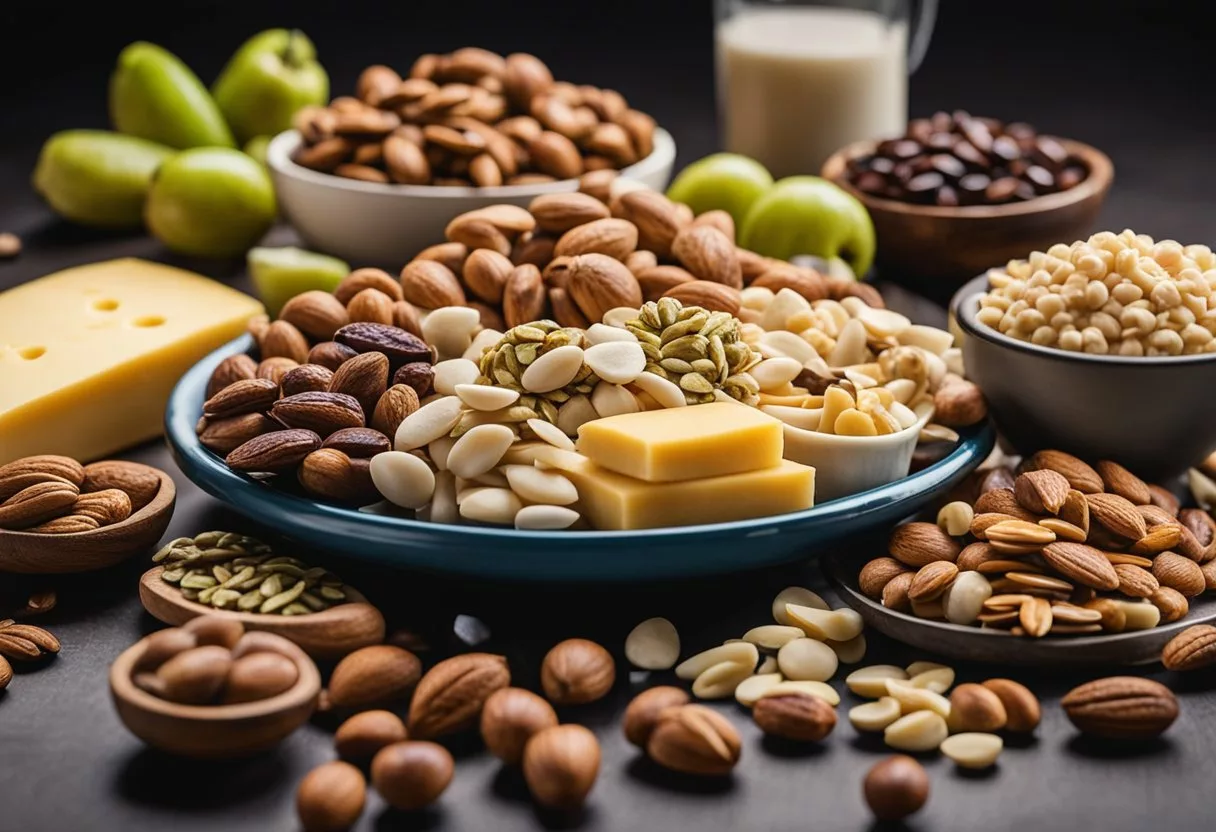
Keto snacks offer valuable benefits for those seeking to lose weight while enjoying convenient and nutritious options. They play a key role in maintaining ketosis, a state where the body burns fat for energy, leading to potential weight loss.
Satiety and Weight Loss
Keto snacks are high in healthy fats and protein, which contribute to a feeling of fullness. They help reduce hunger and cravings between meals, making it easier to maintain a caloric deficit. Foods such as macadamia nuts, cheese, and avocados have low-net carbohydrates, contributing to sustained satiety without significant carbohydrate intake.
Convenient Nutrition
These snacks are not only portable but also densely packed with nutrients. They provide essential vitamins and minerals, and are often rich in heart-healthy monounsaturated and polyunsaturated fats. For those on the go, keto-friendly snacks like olives or seeds offer a quick way to nourish the body with minimal preparation required.
Regulating Blood Sugar Levels
One of the advantages of keto snacks is their role in stabilizing blood sugar levels. Due to their low carbohydrate content, they produce minimal blood sugar spikes compared to high-carb snacks. This is particularly beneficial for individuals looking to manage insulin sensitivity or those with diabetes, as a steady blood sugar level can prevent energy crashes and reduce the risk of developing insulin resistance.
By implementing keto snacks into their diet, individuals may find an advantageous ally in the pursuit of weight loss and overall health.
Ingredients to Focus on in Keto Snacks
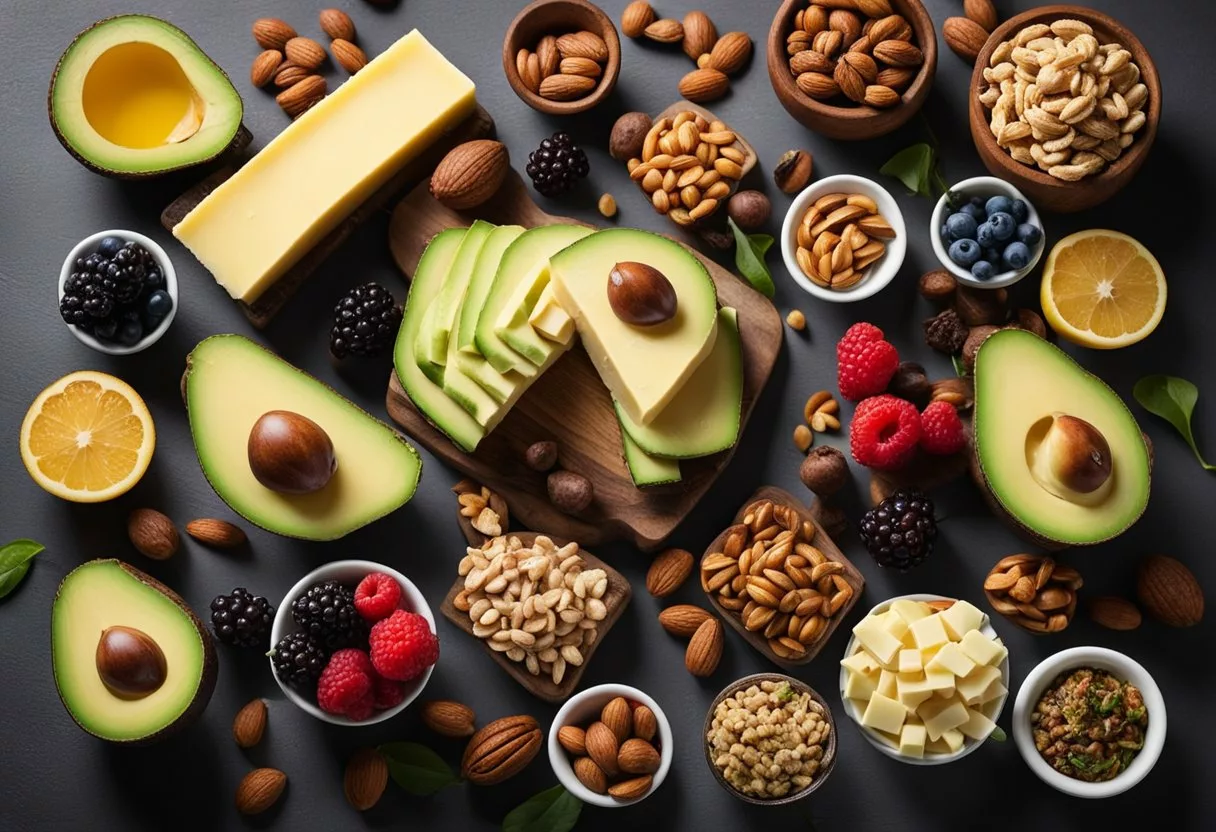
In crafting keto-friendly snacks for weight loss, one should prioritize ingredients that are high in healthy fats and proteins, while being low in carbohydrates. These selections are crucial for maintaining ketosis—a metabolic state conducive to fat burning.
Fats and Oils
For those following a ketogenic diet, fats and oils are foundational. Quality sources to consider include:
- Olive oil: A heart-healthy fat that’s perfect for dressings or drizzling over vegetables.
- Coconut oil: Rich in medium-chain triglycerides (MCTs), it’s ideal for cooking or adding creaminess to recipes.
- Avocado: Provides monounsaturated fat, which can be beneficial for heart health.
Protein Sources
Protein plays a vital role in satiety and muscle maintenance on a keto diet. Optimal protein sources for snacks include:
- Nuts: Almonds, pecans, and macadamias are nutritious options with high protein and fat content, suitable for a quick snack.
- Meats: Lean cuts of beef, poultry, and fish, like salmon, are excellent for their protein and omega-3 fatty acids.
Low-Carb Vegetables
Vegetables are important on the keto diet, but it’s crucial to choose low-carb options, such as:
- Leafy greens: Spinach and kale are nutrient-dense and have minimal impact on blood sugar.
- Cruciferous vegetables: Broccoli and cauliflower can be enjoyed raw, roasted, or as part of a dip.
Cheese and Dairy
Dairy products can be a delicious component of keto snacks, provided one selects options with minimal carbohydrates:
- Cheese: Hard cheeses like cheddar, gouda, and parmesan are high in fat and protein and low in carbs.
- Butter: Grass-fed butter can be used to cook or as a base for keto-friendly fat bombs.
Top Keto Snacks for Weight Loss
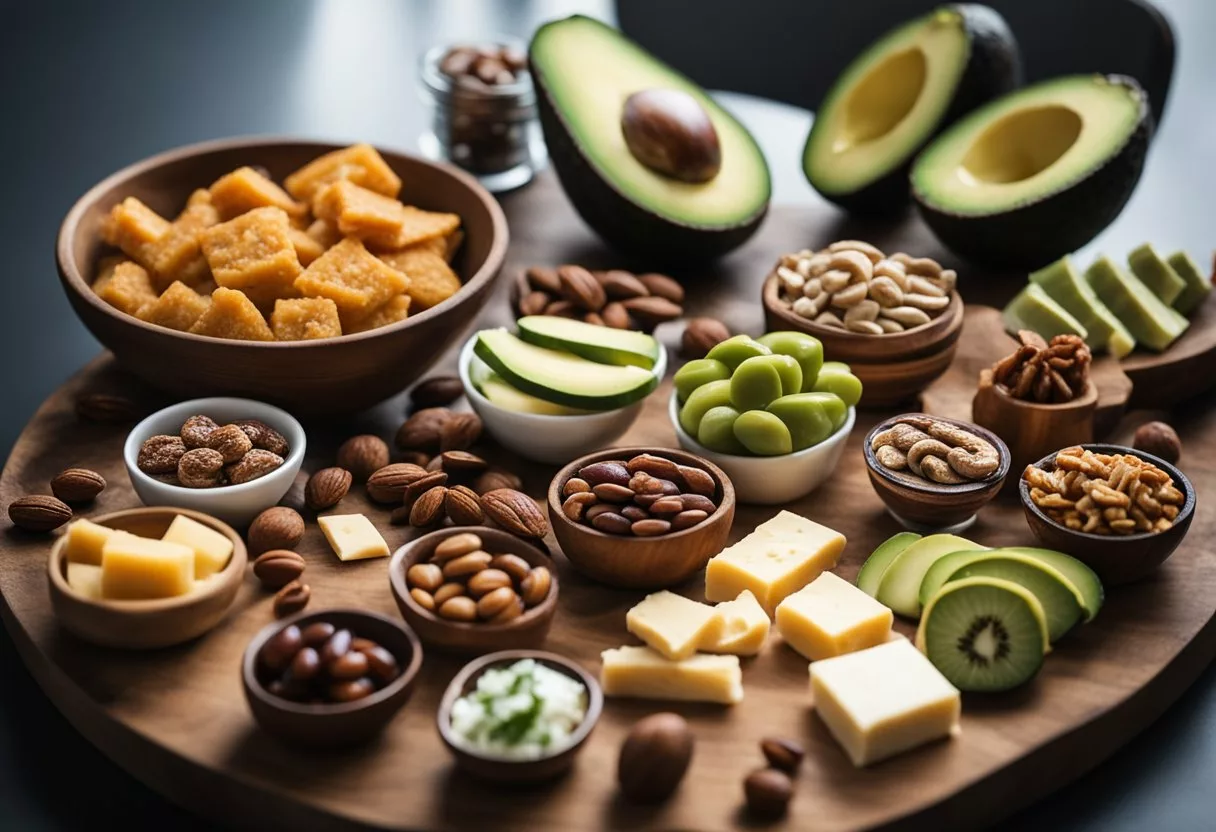
The ketogenic diet emphasizes high-fat, low-carbohydrate foods to encourage the body to burn fat for energy. Snacking on keto-friendly foods can help maintain this metabolic state known as ketosis. Below are optimal snack choices categorized by their primary ingredient that support weight loss on a ketogenic diet.
Nut-Based Snacks
Nuts and seeds are high in healthy fats, fiber, and protein, which can help someone feel full and satisfied. They are ideal for a keto diet due to their low net carb content.
- Almonds: A handful of almonds provides a good source of magnesium and only a few grams of net carbs.
- Macadamia Nuts: With high fat and low carbs, macadamia nuts are perfect for keto. They also provide a good amount of monounsaturated fats.
- Peanut Butter: Pure peanut butter with no added sugar is rich in fat and protein, making it a satisfying keto snack. Always check the label for added carbs.
Dairy-Based Snacks
Dairy options are plentiful on the keto diet and are a great source of calcium and protein.
- Cheese: High in fat and protein, cheese is a go-to keto snack. Options like cheddar, mozzarella, and brie provide satiety with minimal carbs.
- Hard-Boiled Eggs: While not dairy, eggs fit well here as they are a staple in protein-rich keto snacking.
Vegetable-Based Snacks
Vegetables can be a valuable part of the ketogenic diet, particularly those low in carbs and high in fiber.
- Avocados: This fruit (often used as a vegetable) is high in fat and contains only 2 grams of net carbs per 100 grams.
- Olives: Olives are another fat-rich option with very few net carbs, making them an excellent snack for maintaining ketosis.
Meat-Based Snacks
Protein should be a part of every meal and snack to support muscle maintenance and overall health.
- Beef Jerky: Low-carb, high-protein beef jerky can be an excellent snack, but it’s important to choose a jerky that doesn’t contain added sugars or carbohydrates.
- Salmon: Smoked or canned salmon is not only rich in omega-3 fatty acids but also has zero net carbs, making it a superb meat-based snack for those on keto.
DIY Keto Snack Recipes
Crafting homemade keto snacks is a great way for individuals to stay on track with their weight loss goals while enjoying delicious, low-carb treats. These DIY options provide a satisfying way to curb hunger between meals.
Fat Bombs
Fat bombs are a keto dieter’s dream for a quick energy boost while keeping carbs low. They are typically made with a base of nut butter, seeds, or coconut oil, enhanced with various flavors and textures.
- Chocolate Peanut Butter Fat Bombs: Combine 1 cup peanut butter with 1/2 cup coconut oil and unsweetened cocoa powder. Sweeten with stevia, pour into molds, and freeze until solid.
- Coconut Berry Fat Bombs: Mix 1 cup coconut oil with 1/2 cup mixed berries and a dash of vanilla extract. Divide into mini cupcake liners and refrigerate.
Dips and Spreads
Dips and spreads are versatile, perfect for pairing with keto-friendly vegetables or flaxseed crackers.
- Cheesy Avocado Dip: Blend ripe avocados with cream cheese, shredded cheddar, garlic, and lime juice for a creamy and tangy spread.
- Spicy Salsa Verde Dip: Process roasted tomatillos, jalapeños, cilantro, and lime juice for a low-carb kick that pairs well with homemade keto chips.
Homemade Chips and Crackers
Chips and crackers made from almond flour or cheese can satisfy the crunch cravings without the added carbs.
- Cheesy Crackers: Combine 2 cups shredded mozzarella with 1 cup almond flour and roll out thinly. Cut into squares and bake until crispy.
- Zucchini Chips: Thinly slice zucchinis, lightly coat with oil, sprinkle with sea salt, and bake at a low temperature until they’re crispy.
Each of these recipes can be tailored to individual tastes and dietary requirements, offering a delicious way to help maintain one’s keto lifestyle.
Commercial Keto Snack Options
When choosing commercial keto snacks for weight loss, consumers should look for options with high healthy fats and very low net carbs. They should also be mindful of added sugars and sodium contents, which can impact ketosis and overall health.
Bars and Ready-Made Treats
Keto-friendly bars provide a convenient on-the-go option. Look for products with high-quality ingredients such as nuts, seeds, and chocolate with no added sugar. Typical ingredients might include almonds, cocoa butter, and sweeteners such as erythritol or stevia. For example, a chocolate bar manufactured specifically for ketogenic diets might use unsweetened chocolate and keto-approved sweeteners to keep carbs low.
- Example Snack Bars:
- Keto Chocolate Bars (high in fats, no added sugars)
- Almond Butter Based Bars (with added pumpkin seeds)
Jerky and Dried Meats
Beef jerky and other dried meats are excellent sources of protein and can be satisfactory keto snacks. Shoppers should opt for versions that are low-carb and without added sugars. It’s worth noting that while they are convenient, some jerkies can be high in sodium, which might be a consideration for those monitoring their sodium intake.
- Jerky snack criteria:
- Low-Carb: Ideally, under 5g of carbs per serving.
- Minimal Ingredients: Focus on jerky with the fewest additives.
Packaged Nuts and Seeds
Nuts and seeds are staples in the keto diet due to their fat content and low net carbs. Packaged varieties such as macadamia nuts, pecans, and Brazil nuts are particularly keto-friendly, while cashews are usually higher in carbs. Pumpkin seeds are another excellent option, offering both healthy fats and protein. One needs to consume these in moderation due to calories.
- Packaged Nut and Seed Snacks:
- Macadamia Nuts (low in net carbs)
- Roasted Pumpkin Seeds (for a crunchy, satisfying snack)
By carefully selecting these commercial keto snack options, individuals can enjoy convenient, tasty treats that align with their weight loss goals while adhering to the ketogenic diet’s requirements.
Snacking Strategies for Keto Success
Effective keto snacking supports weight loss by managing hunger while maintaining a state of ketosis. It is crucial to balance snacks in terms of calories and macronutrients to avoid disrupting meal patterns.
Portion Control
To ensure snacks contribute positively to a keto diet, one must be mindful of serving sizes. Overconsumption, even of keto-friendly foods, can lead to calorie surplus and weight stagnation. For instance, a small handful of macadamia nuts is a satisfying choice but can quickly accumulate in calories if not portioned correctly.
Avoiding Common Pitfalls
Avoid high-carb temptations that can knock one out of ketosis. Snacks like cheese crisps offer the crunch many crave without the carbs found in regular crackers. Keep easy-to-eat, low-carb options available to quench sudden hunger pangs and minimize the risk of reaching for non-compliant snack options.
Incorporating Snacks into Meals
Snacks can be effectively incorporated into meal plans by using them as mini-meals. This strategy controls hunger and provides steady energy. For example, a couple of celery sticks with guacamole can serve as a bridge between meals while aligning with keto macronutrient goals by providing healthy fats and fiber.
Nutritional Considerations and Health Impacts
When selecting keto snacks for weight loss, one must carefully consider the nutritional content. Snacks should be chosen not just for their low carbohydrate value but for their ability to provide essential nutrients and support long-term health.
Micronutrient Intake
On a ketogenic diet, there are potential risks of micronutrient deficiencies due to the exclusion of certain food groups. Individuals should focus on snacks that are rich in vitamins and minerals to ensure adequate micronutrient intake. Snacks with high fiber content are beneficial for digestive health and can also provide essential micronutrients. For example, nuts and seeds can offer magnesium, while dark leafy greens are a good source of vitamin C and calcium.
Balancing Omega Fatty Acids
Consumption of healthy fats is a cornerstone of the ketogenic diet, and balancing omega-3 and omega-6 fatty acids is crucial for reducing inflammation and promoting heart health. Snacks that include fatty fish like salmon or sardines are high in omega-3 fats, which can help counterbalance the higher omega-6 fat intake from foods such as nuts and cheeses.
Long-Term Health Effects
The long-term health impacts of a ketogenic diet are still under research. However, a doctor may sometimes recommend the diet for weight loss or to manage certain health conditions. Keto snacks should be part of a well-rounded diet that supports overall health and does not rely heavily on processed foods. A focus on whole food sources like avocados, olives, and low-carb vegetables ensures the intake of adequate nutrients and minimizes the risk of chronic diseases associated with diets high in processed foods and saturated fats.
Frequently Asked Questions
Selecting the right keto snacks can make a significant difference in maintaining ketosis and supporting weight loss. This section addresses common queries regarding keto snacking options.
What are some convenient keto snacks for on-the-go eating?
Individuals following a ketogenic diet can enjoy a variety of portable snacks, such as cheese cubes, avocados, macadamia nuts, and olives, which are high in healthy fats and low in carbs.
How can one identify keto-friendly chips or snack alternatives?
Keto-friendly chips are typically crafted from low-carb vegetables or cheese. Consumers should check the net carb content on the packaging to ensure it aligns with their dietary requirements.
Can you suggest some easy keto snack options for the workplace?
For workplace snacking, items like hard-boiled eggs, pre-packaged guacamole, and nuts are not only easy but also minimally disruptive and can be stored conveniently at one’s desk or in a common refrigerator.
Are there particular keto snacks that are beneficial for weight loss?
Foods like celery with almond butter, cucumber slices with cream cheese, and seaweed snacks offer a satisfying crunch with minimal caloric impact, aiding in weight loss goals.
Could you provide some examples of low-calorie snacks suitable for a keto diet?
Low-calorie, keto-compatible snacks include leafy green salads with a vinaigrette dressing, tuna salad lettuce wraps, and zucchini chips, which are not only tasty but also help sustain energy levels without excess calories.
What are some affordable keto snack choices that don’t compromise dietary goals?
Affordable snack options that comply with a ketogenic lifestyle include boiled eggs, canned fish like sardines or tuna, and homemade cheese crisps, balancing cost-efficiency with nutritional benefit.